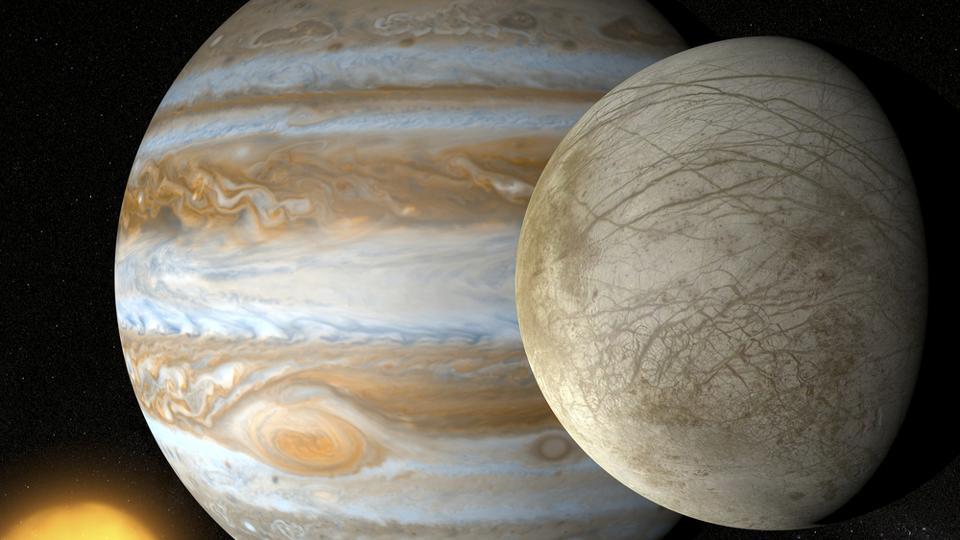Carbon Dioxide, an Essential Element for Life, Found on Jupiter’s Moon Europa
27th Sep 2023
In a groundbreaking discovery, NASA has found evidence that sheds light on the potential for extraterrestrial life on another body in our Solar System. Europa, one of Jupiter’s icy moons, has long been of special interest to scientists and is believed to have the right conditions for life.
Recent findings using the James Webb Space Telescope now take us closer to understanding if there might be life on Europa. Traces of Carbon Dioxide, a key element for life on Earth, were discovered in one of the moon’s regions. While this information alone is insufficient for a definitive conclusion, it offers us valuable insights into the potential for life beyond our planet.
Europa’s Space Mystery
Europa, the sixth-largest moon in our solar system, captivates us for what lies beneath its icy surface–a saline ocean estimated to be twice the volume of Earth. This Ocean, approximately 25 kilometres below the frozen exterior, is thought to have an important connection with the surface, potentially nurturing an environment for aquatic life. Europa is set apart from other celestial bodies because of its unique blend of elements, including liquid water, essential molecules, and geological activities, which are all crucial for the potential emergence of life.
The carbon dioxide recently discovered was in an area called Tara Regio only and not throughout the whole moon. This probably means that elements have been shared between the underground ocean and the icy surface in that specific region.
Previous records from the telescope did indicate salty material in this region, and now, with the help of a special tool called NIRSpec, scientists have found a huge region covered with carbon dioxide there as well. Carbon dioxide does not stick around in one place for a long time, meaning that the traces found on Europa only arrived recently. These observations made in such a short time hint at the amazing solar system discoveries that are yet to come.
Details on the Webb Telescope’s Discovery
These recent insights from the James Webb Space Telescope have put it into the spotlight for the whole world, piquing curiosity about how evidence of a gas was found on a body so far away. Researchers have pinpointed the presence in one specific area by checking the data from the telescope’s Near-Infrared Spectrograph. Spectroscopy works by analyzing various properties of electromagnetic radiation, such as emitted or absorbed wavelengths, and it played a key role in the breakthrough. This finding carries immense significance, as it implies that the carbon likely originated from Europa’s internal ocean rather than being delivered by an external source like a meteorite.
This discovery of carbon dioxide in Tara Regio, which is shown as chaotic terrain and jagged ridges, again shows an interplay between the subsurface ocean and the surface. While the exact mechanisms driving these formations are still unknown, the implications are profound. We’ve obtained images of Europa through previous spacecraft such as Galileo (1989-2003), but with upcoming missions planned, we’re poised to dive deeper and unearth further secrets regarding life on Europa.
Missions Set to Uncover Europa’s Secrets
There are multiple missions in the work to uncover the secrets of Jupiter and its moons, with one of them already commenced earlier this year. Simultaneously, the European Space Agency’s Jupiter Icy Moons Explorer (JUICE) mission, launched in April 2023, will significantly help us understand Europa’s surface chemistry through planned flybys in the year 2032.
NASA’s upcoming Europa Clipper spacecraft, due to launch in October next year, will also embark on a series of close flybys, which will help us gain valuable insights into Europa’s composition and any potential plume activity.
With its hidden ocean and secrets, Europa stands out as one of the hopes for human settlement along with our Moon and the planet Mars. While it is still too early to predict which celestial body we can terraform, events like these suggest where our future might lie. We are currently at the cusp of a new era in our history where we are seeking alternatives for life in other parts of space rather than just on Earth.







Thank you for your comment! It will be visible on the site after moderation.